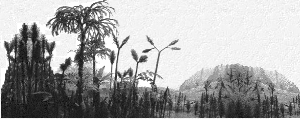|
Taxon / Subject
|
Web Source
|
Comments
|
Pics
|
Info
|
| Gilboa
Forest |
Prof. Robert Titus, Hartwick College |
|

|

|
| Progymnosperms |
University of California Museum of Paleontology, Berkeley |
|

|
 
|
| Tetraxylopteris |
| Tetraxylopteris
schmidtii |
Virtual Paleobotany Laboratory |
|

|

|
| The genus
Archaeopteris
was originally established for Devonian foliage with fan-shaped
pinnules. Archaeopteris is very widespread and has been
reported
from North and South America, Europe and Aisa; several localities
have yielded very large frond portions, e.g., Bear Island (Arctic),
Kiltorckan
(Ireland). The leaves bear macro- and microsporangia which are roughly
of the same size and shape. The foliage has been correlated with the
petrified
wood Callixylon and the name Archaeopteris
is also used for the reconstructed plant. |
| Archaeopteris |
University of California Museum of Paleontology, Berkeley |
|

|
 
|
| Archaeopteris |
Kathleen Pigg's "Plant Fossils and Evolution" |
Sterile and fertile leaves |

|

|
| Archaeopteris |
Paleontologisk Museum, Oslo |
|

|

|
| Archaeopteris |
Andrew Drinnan, School of Botany, University Melbourne |
|

|

|
| Archaeopteris |
Media del Gekko |
|
  
|
  
|
| Archaeopteris |
ABC News - Science |
Same pictures as above |
  
|
  
|
| Archaeopteris |
Botanik-online |
|

|

|
| Archaeopteris |
CNRS |
News item - mainly text |

|
 
|
| Archaeopteris |
The Forestry Source |
News item - mainly text |

|

|
| Archaeopteris |
Andrew Drinnan, School of Botany, University Melbourne |
Reconstruction |
 
|

|
| Archaeopteris |
Andrew Drinnan, School of Botany, University Melbourne |
Fertile specimen |
  
|

|
| Archaeopteris |
Andrew Drinnan, School of Botany, University Melbourne |
Fertile specimen, detail |
  
|

|
| Archaeopteris |
Andrew Drinnan, School of Botany, University Melbourne |
Fertile specimen |

|

|
| Archaeopteris |
Andrew Drinnan, School of Botany, University Melbourne |
Sterile pinnules |
  
|

|
| Archaeopteris |
Andrew Drinnan, School of Botany, University Melbourne |
Fertile specimen |
  
|

|
| Archaeopteris
gaspensis |
Virtual Paleobotany Laboratory |
|
 
|

|
| Archaeopteris
halliana |
Senckenberg, Frankfurt am Main |
Illustration on a stamp ! |
 
|

|
| Archaeopteris
hibernica |
The Cork Geology Museum (Ireland) |
|

|

|
| Archaeopte
ris
and Callixylon |
R.A. Spicer, The Open University, Milton Keynes |
|
  
|
  
|
| Callixylon
is the wood of the Archaeopteris tree |
| Callixylon |
Virtual Paleobotany Laboratory |
radial section |
  
|

|
| Callixylon |
Virtual Paleobotany Laboratory |
tangential section |
 
|

|
| Callixylon |
Virtual Paleobotany Laboratory |
permineralized trunk |

|

|
| Callixylon |
Andrew Drinnan, School of Botany, University Melbourne |
Transverse section |
  
|

|
| Callixylon |
Andrew Drinnan, School of Botany, University Melbourne |
|

|
 
|
| Callixylon |
Plant fossils of Kentucky, KGS |
|
 
|

|
| Callixylon |
University of California Museum of Paleontology, Berkeley |
same picture as above, in reverse! |

|

|

